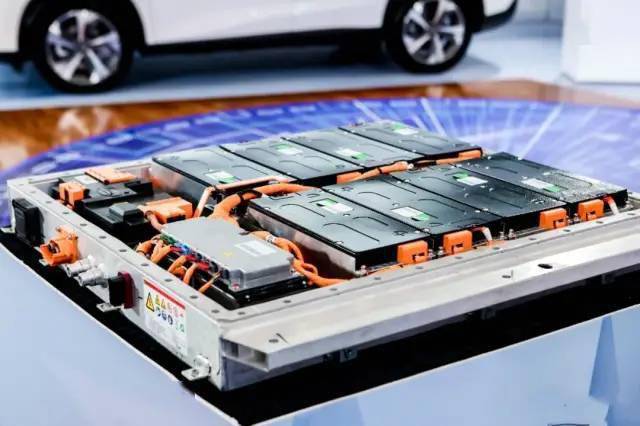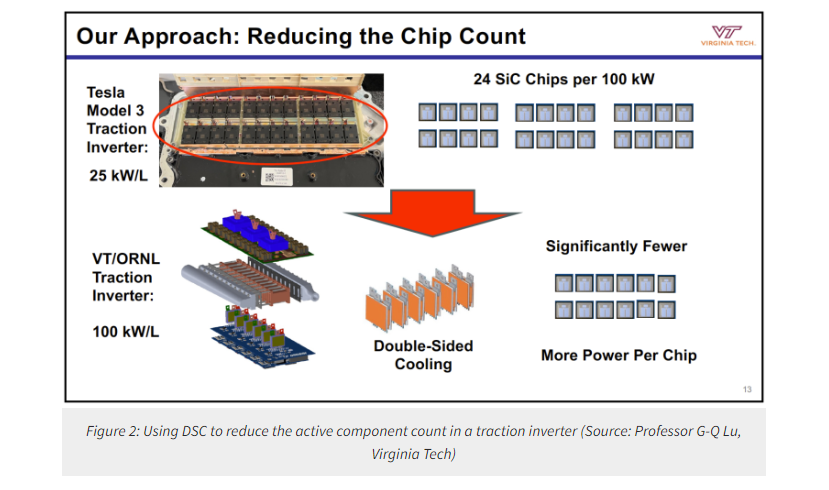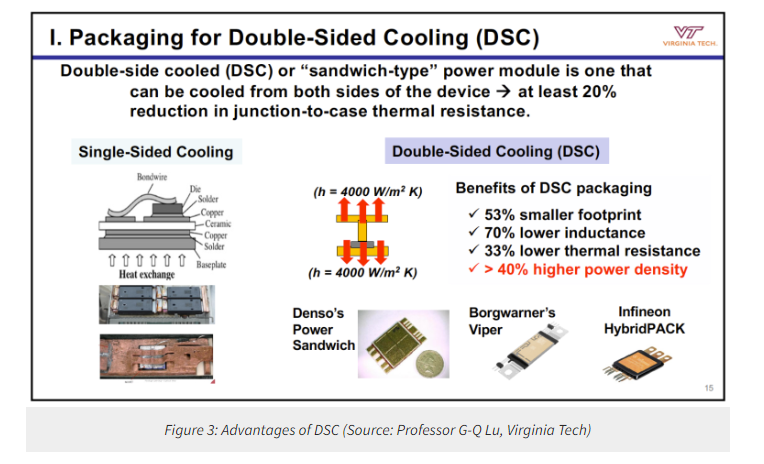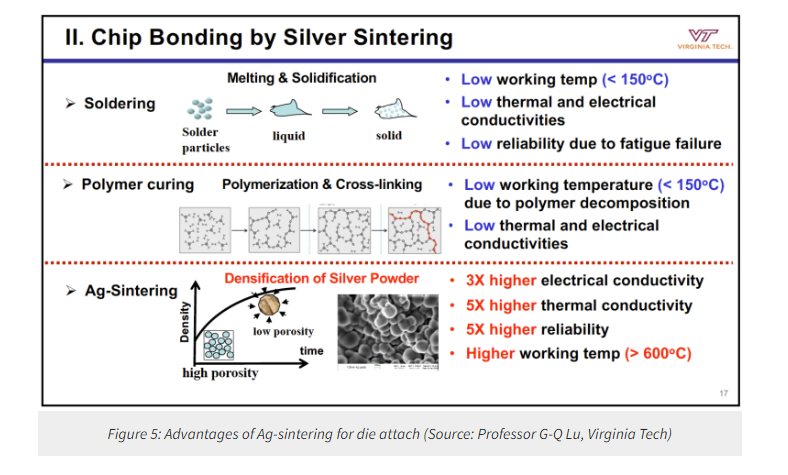
A key goal of de-carbonization is the electrification of everything. To this end, electric vehicles (EVs) are transforming the personal and commercial transportation sector with estimates of EVs representing over 58% of all new car sales by the year 2040. The bottlenecks here lie in the lack of sufficient charging infrastructure (outside of the driver’s home), a limited driving range, and long charging times.
Solutions are being rolled out for each of these. The increase in the EV battery voltage to 800 V, along with standards such as the DCFC-Level 3, drastically improves efficiency and reduces charging times. Wide bandgap (WBG) semiconductors such as silicon carbide (SiC) and gallium nitride (GaN) can substantially improve the power conversion efficiency in the traction inverters, on-board converters, and DC-DC converters that make up the power conversion blocks in an EV.
In this article, we will highlight work done by Professor G-Q Lu at the Center for Power Electronics Systems, Virginia Tech, USA on the creation of double-side cooled (DSC) SiC modules that can show vast improvements in traction inverter performance compared to conventional single side cooled (SSC) modules.
Traction Inverter Targets
The U.S. Department of Energy (DOE) has target goals for the electric drive technology (EDT) traction inverters used in EVs. Some key targets are listed in Figure 1.

The traction inverter volumetric power densities in most state-of-the-art (SOTA) EVs range from < 10 kW/L for a SSC-IGBT-based inverter, to around 25 kW/L for a SSC-SiC based inverter. The 100 kW/L represents a large leap forward in this key metric. Let’s examine below the CPES approach to meeting this target.
Approach to Improving Traction Inverter SiC Module Packaging
As shown in Figure 2, the VT/ORNL strategy to achieve the above goals for the traction inverter leverages the improved performance of the DSC modules to significantly reduce the SiC chip count, hence leading to power density and cost advantages.

A combination of solutions were used to achieve the overall objective, each of which is summarized below.
Double-sided cooling
This can reduce the thermal resistance Rth-JC by over 30 %. In addition, as shown in Figure 3, significant improvements in power density and lower inductance (from not using bond wires) can be achieved.

Professor Lu’s group has used an innovative approach to achieve the DSC in the module. With DSC, the device chips are typically sandwiched between two electrically and thermally conductive substrates. Previous approaches to the top connection have used short metal posts covering a portion of the device area, as shown in Figure 4(a). Many materials have been tried for the post, such as Cu (this introduces more thermo-mechanical stress), Mo (this has lower thermal conductivity and needs a surface metallization), etc. Ag sintering has several advantages over soldering for the backside die-attach, with higher thermal and electrical conductivity as well as improved reliability. In his work, posts were porous Ag made by low-temperature sintering of a pressure-less Ag sinter paste1.
A key advantage of using these porous posts is that they could easily be deformed during the formation of the top contact and hence accommodate geometric variations, such as differences in substrate thicknesses. Figure 4(b) illustrates these Ag posts. The many advantages of sintered silver over solder for die attach are translated now to the topside attach as well, along with the advantages of low elastic modulus and hence lower electromechanical stress than Cu or Mo posts.

Nano-silver sintering for die attach
Ag sintering uses solid-state diffusion at a temperature of 250˚C or less, with or without pressure assist. As shown in Figure 5, Ag sintering has several advantages over legacy solder approaches. Professor Lu’s team used a nano-silver paste, mixed with surfactant and organic thinner. This increases the rate of densification, for a given temperature and pressure condition, improving bond-line cohesion and adhesion.

Use of Rigid Encapsulant
The encapsulant that fills the space between the die in the module plays a key role in the reliability of the module. The Coefficient of Thermal Expansion (CTE) of this material needs to be low so that the module can be reliably used across the specified temperature range. Professor Lu’s group tried three different encapsulation materials, as shown in Figure 6. The high elastic modulus of the preferred EP-2000 material helped reduce the cyclic inelastic strain energy density or damage at different bonded interfaces, thus improving the reliability of the module.

Improving Insulation with Field Grading
The Partial Discharge Inception Voltage (PDIV) is the voltage at which the module’s insulation starts to degrade. Methods to improve this can include the use of thicker or stacked substrates, or the use of a field grading material at the highest electric field points within the module. A nonlinear resistive field grading (NLRFG) material can reduce the electric field stress in the insulation through a rapid increase in electrical conductivity. In the module, the triple points, i.e., the interface of the metal, ceramic, and insulator, are locations of the highest field stress. In this work, an NLFRG material made of a polymer nano-composite (PNC) coating that is applied by physically painting the module triple points, as shown in Figure 7, has been demonstrated to significantly improve the insulation of the power modules.

Module Results
For EV traction inverters, prototypes of a DSC 1.2kV SiC phase leg module were built. Temperature testing results to 200˚C are shown in Figure 8. The improved cooling and use of sintered-Ag bonding show that the operational temperature can be increased, potentially allowing the SiC junction temperature to go as high as 250˚C.

Figure 9 depicts a 10 kV DSC SiC module, consisting of 10 kV SiC devices to form a full-wave diode rectifier module. The combination of approaches highlighted above helps achieve high power density, high temperature, and high-voltage operation.

Conclusion
Innovations in power module packaging can increase power density and reduce materials such as SiC and Cu for a lower cost and more sustainable power conversion in EV applications. The innovative DSC approach highlighted in this article can be one of many solutions used to improve the traction inverter performance in EVs and converters for renewables.
About US
Heisener Electronic is a famous international One Stop Purchasing Service Provider of Electronic Components. Based on the concept of Customer-orientation and Innovation, a good process control system, professional management team, advanced inventory management technology, we can provide one-stop electronic component supporting services that Heisener is the preferred partner for all the enterprises and research institutions.
